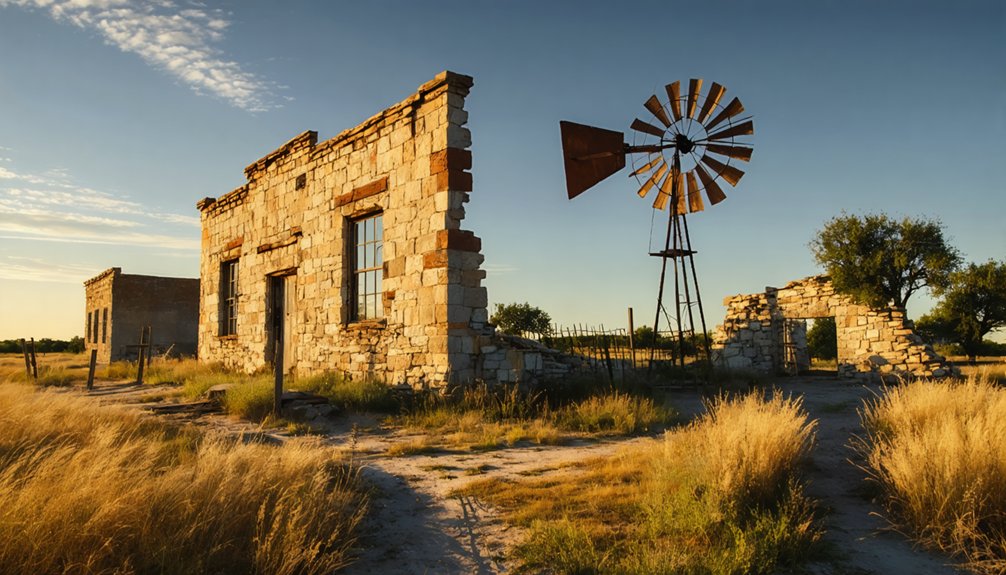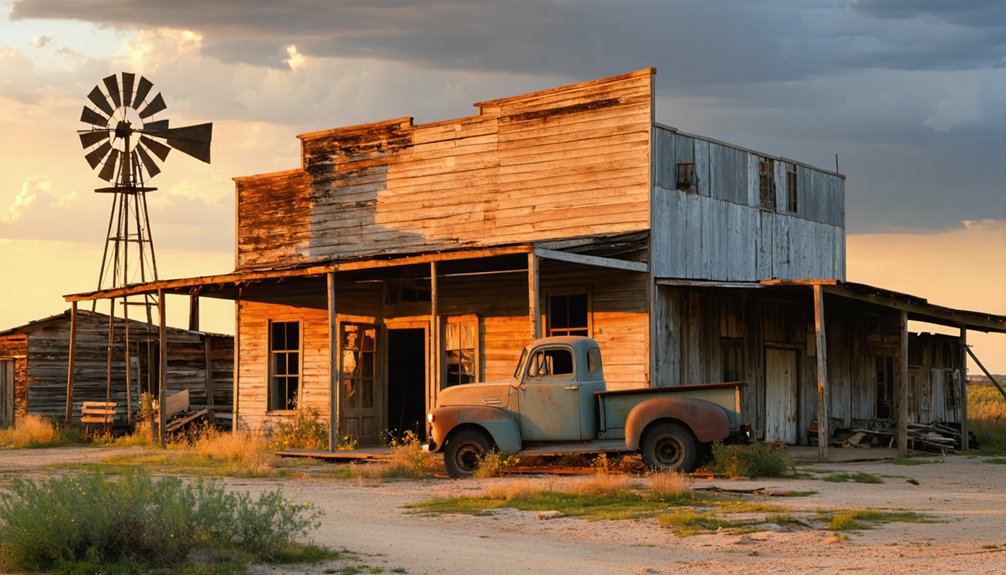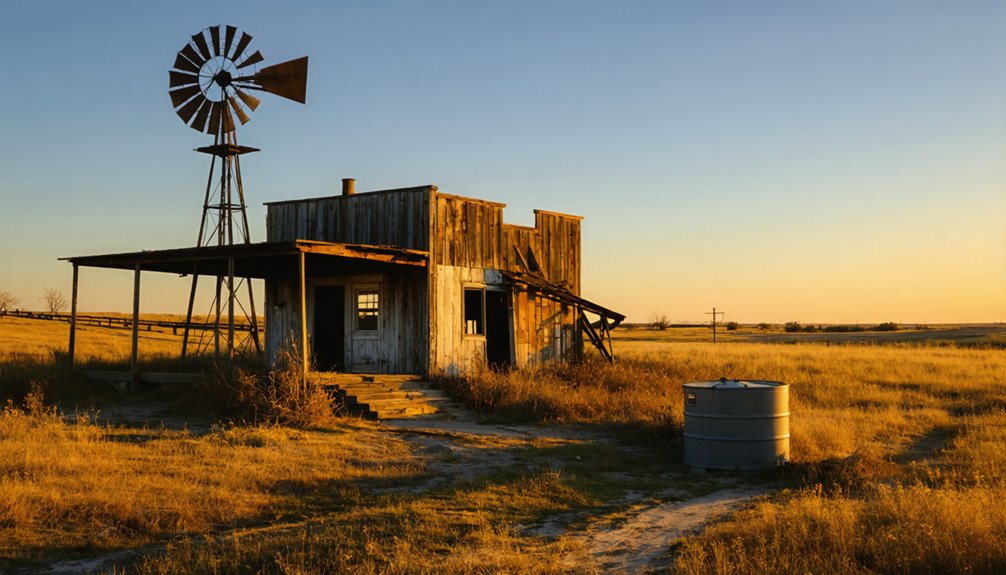You’ll find Luxello 18 miles northeast of San Antonio, where it emerged in 1900 as a railroad settlement called Landa along Cibolo Creek. After Charles Lux established a post office in 1915, the town was renamed in his honor and grew to 35 residents. The community thrived around Luxello Hall and the General Store until post-WWII urban migration led to its decline. Today, weathered structures and overgrown paths reveal a fascinating chapter of Texas history.
Key Takeaways
- Luxello was established in 1900 along Cibolo Creek near San Antonio, named after Charles Lux, its first postmaster in 1915.
- The ghost town is located 18 miles northeast of San Antonio at coordinates 29.59916, -98.31528, accessible through rural roads.
- Luxello Hall and the General Store were central community hubs before the town’s post-World War II decline and abandonment.
- Economic downturn, population loss, and urban migration led to Luxello’s transformation from a thriving community into a ghost town.
- Today, visitors can explore unrestored historical structures, including Luxello Hall, which showcase early 20th-century Texas architecture and history.
The Birth of a Settlement: From Landa to Luxello
While many Texas ghost towns faded into obscurity without leaving much of a trace, Luxello’s origins can be traced back to its early days as a settlement called Landa around 1900.
You’ll find this community’s settlement origins along Cibolo Creek, where the Missouri, Kansas and Texas railroad line created an ideal spot for development.
The naming significance of Luxello stems from Charles Lux, who became the town’s first postmaster when he established a post office in 1915.
Though the post office’s existence proved brief, it marked an important milestone in the settlement’s evolution from Landa to Luxello.
With 35 residents recorded during the post office’s operation, you can imagine a small but hopeful community taking shape along the railroad tracks.
Like many towns that lost their prominence, Luxello’s fate was sealed when accessibility became impossible due to private ownership.
The Luxello General Store served as the heart of the community’s daily life and commerce.
Early 20th Century Community Life
Although Luxello never grew into a large settlement, its early 20th century community life centered around several essential establishments that served as social and commercial anchors.
The Luxello Hall and General Store formed the heart of daily activities, hosting social gatherings where the town’s 35 residents would connect and trade. You’d find farmers discussing agricultural practices, while others picked up daily necessities at the store. Like many company towns of that era, workers were required to use company scrip for purchases. Much like the historic Gruene General Store, these establishments were vital to maintaining community connections.
The humble general store buzzed with daily life as farmers gathered to share wisdom and neighbors stocked their pantries.
The Missouri, Kansas and Texas railway station linked the community to broader markets, while Cibolo Creek supported local farming.
Luxello’s residents maintained strong ties with neighboring Bracken and Selma, creating a vibrant rural network. Despite the modest population declining to 25 by 1930, the tight-knit community preserved its essential structures and social bonds through the mid-1930s.
The Short-Lived Post Office Era
The establishment of Luxello’s post office in 1915 marked a notable expansion of the community’s services beyond its general store and railway station.
Charles Lux, who’d serve as the first postmaster, saw his name become permanently linked to the town’s identity when it was renamed in his honor.
Despite its post office significance as a symbol of federal recognition and rural communication hub, Luxello’s postal operations proved short-lived. Like many small Texas post offices, mail delivery relied on slow wagon trains for transportation.
The town reached its peak of 35 residents the same year the post office opened.
You’ll find that within just a few years of opening, the facility closed its doors, signaling the beginning of the settlement’s decline.
The post office’s brief existence paralleled many similar rural Texas communities of the era, where shifting populations and evolving mail routes led to consolidation.
Today, the post office chapter remains an essential marker in tracking Luxello’s transformation into a ghost town.
Notable Landmarks and Structures
As you explore Luxello’s ghostly remains today, you’ll find the weathered Luxello Hall standing prominently alongside the Davenport House, both structures preserving over a century of the town’s social history.
The former post office location, while no longer standing, once served as a crucial communication hub near these surviving buildings during the community’s brief but active period. Like Terlingua’s mines, which produced 40% of quicksilver during World War I, Luxello experienced its own bustling period of activity.
Throughout the area, scattered building foundations and partial ruins of wood-frame structures provide silent testimony to the town’s early-1900s commercial and residential development. These architectural remnants attract history and architecture tourists who come to study and photograph the town’s remaining structures.
Historic Luxello Hall
Standing as one of Luxello’s last physical remnants, Historic Luxello Hall exemplifies early 20th-century rural Texan architecture through its wood-frame construction and functional design.
Like many semi-abandoned towns in Texas, the hall’s architectural significance stems from its role as a crucial community hub during the town’s brief but active period. The building later transformed into the Cibolo Creek Country Club.
While time hasn’t been kind to this historic structure, you’ll still find:
- Original doors and windows, though weathered by decades of abandonment
- Interior spaces that once hosted spirited community gatherings and town meetings
- Construction features typical of early 1900s Texas building methods
- A rare glimpse into Luxello’s social fabric before its post-WWII decline
Today, the hall stands untouched and unmaintained in Bexar County, drawing ghost town enthusiasts and historians who seek to document its deteriorating but historically important presence.
Post Office Location
Luxello’s first post office opened its doors in 1915 under postmaster Charles Lux, who lent his name to both the facility and the growing railroad town.
You’ll find that the post office’s location was strategically placed near the Missouri-Kansas-Texas Railroad line and Cibolo Creek, about eighteen miles northeast of downtown San Antonio.
While no confirmed building remains today, historical records indicate the post office was situated close to the Luxello General Store in what served as the town’s central business district.
This location strengthened the community’s identity until the facility’s closure in 1919. After that, mail services shifted to nearby Boerne, marking the beginning of Luxello’s gradual decline.
The post office’s short-lived presence represented both the town’s brief prominence and eventual fade into ghost town status.
Remaining Building Foundations
The remaining building foundations in Luxello tell a compelling story of this once-bustling Texas railroad town.
These architectural remnants, now weathered by time, showcase the town’s diverse foundation preservation across industrial, agricultural, and social structures.
You’ll discover significant landmarks throughout the ghost town:
- The iconic Luxello Dance Hall stands as the most intact structure, representing the community’s vibrant social life.
- Mining equipment foundations and metal framework reveal the town’s industrial backbone.
- Ranch and farmhouse foundations, complete with corrals and irrigation channels, outline the agricultural heritage.
- Residential foundations, featuring stone and brick bases, cellars, and root storage, demonstrate how settlers adapted to local resources.
These foundations provide vital insights into early 20th-century Texas construction methods and community planning.
Economic Factors Behind the Decline
Following World War II, you’d find Luxello’s population rapidly diminishing as residents sought better opportunities in Texas’s growing urban centers.
The town’s business infrastructure couldn’t sustain itself as shops, services, and the local post office shuttered their doors one by one due to insufficient customer base.
This commercial collapse created a downward spiral, where remaining residents faced increasingly limited access to essential services, forcing them to relocate and further weakening Luxello’s economic foundation.
Post-War Population Exodus
Rural decline struck Luxello with devastating force after World War II, as residents abandoned their homes and farms for promising opportunities in Texas’s growing urban centers. The population dynamics reflected a broader pattern of rural migration that transformed the region’s demographic landscape.
Key factors that drove the exodus from Luxello included:
- Higher death rates than birth rates, creating an unsustainable population imbalance.
- Young families relocating to Dallas-Fort Worth and other urban areas for better employment.
- Declining birth rates in the community, which accelerated the town’s demographic collapse.
- Mass migration to suburban areas that offered modern amenities and economic opportunities.
This post-war population shift fundamentally altered Luxello’s character, ultimately contributing to its transformation into a ghost town as residents sought brighter futures elsewhere.
Failing Business Infrastructure
Economic instability ravaged Luxello’s business infrastructure through a perfect storm of challenges that crippled local commerce.
You’ll find the town’s reliance on a single industry left it vulnerable when market shifts hit, triggering widespread business deterioration. As property values plummeted by 47% and mortgage rates climbed to 7%, local spending power evaporated, forcing many establishments to close their doors.
Infrastructure neglect accelerated as tax revenues dried up, creating a vicious cycle.
You can see it in the abandoned gas stations and empty storefronts that now dot the landscape. Without diverse economic sectors to cushion the blow, each business closure weakened the remaining enterprises.
The lack of community roots and proper planning made it impossible for new businesses to take root, leaving Luxello’s commercial heart to wither.
Post-World War II Transformation

While many small Texas towns managed to survive the post-war era, Luxello’s transformation into a ghost town accelerated dramatically after World War II.
The demographic shifts and social changes proved too overwhelming for this once-vibrant community to overcome.
You’ll find the town’s decline was marked by four major changes:
- Mass exodus of residents to urban areas in search of employment opportunities
- Closure of essential services, including the post office that had operated since 1915
- Agricultural mechanization that eliminated local farming jobs
- Infrastructure bypasses that diverted traffic and commerce elsewhere
Today, only Luxello Hall and a few deteriorating structures remain as silent witnesses to the town’s past.
The abandoned buildings, now open for casual exploration, stand as remnants of a community that couldn’t weather the post-war transformation.
The Last Traces of a Forgotten Town
Today, virtually nothing remains of Luxello’s once-vibrant community except for the haunting shell of Luxello Hall and scattered ruins reclaimed by nature.
You’ll find few markers or signs to guide your way, as vegetation has obscured former streets and building foundations. The town’s physical traces have largely disappeared, leaving only fragments for modern explorers to discover.
Community memories persist mainly through local historians and scattered oral histories from descendants of Bexar County residents.
If you’re hoping to explore Luxello’s remains, you’ll face significant challenges – the site’s isolation and unregulated access mean you’re largely on your own.
While social media occasionally brings fleeting attention to this forgotten place, Luxello’s story remains overshadowed by Texas’s more famous ghost towns.
Historical Impact on Bexar County

You’ll find Luxello’s brief existence as an agricultural settlement helped establish early 20th-century development patterns in rural Bexar County, even though its post office operated only briefly in 1915.
The community’s eventual decline reflected broader economic shifts as Bexar County moved away from small-scale farming communities toward urban concentration after World War II.
While Luxello no longer appears on modern maps, its story exemplifies how rural settlements shaped the county’s agricultural heritage and contributed to the region’s cultural evolution from Spanish colonial times through the early 1900s.
Early Community Development Impact
As one of many settlements that emerged during Bexar County’s early growth period, Luxello played a distinct role in the region’s development after 1900.
You’ll find that the community dynamics shaped settlement patterns throughout the area, establishing foundations that influenced rural Bexar County’s evolution.
Here’s how Luxello impacted early community development:
- Established essential infrastructure with a post office in 1915, demonstrating the area’s growing connectivity needs.
- Created a social hub through Luxello Hall, fostering community gatherings and local culture.
- Contributed to the region’s agricultural development by supporting local trade and farming activities.
- Served as a prototype for small-town development in Bexar County, though its sustainability challenges later influenced regional planning approaches.
Economic Effects Through Decline
While Luxello’s early community development laid promising groundwork, the town’s economic decline after the 1980s reshaped Bexar County’s rural landscape.
You’ll find that rural depopulation created rippling effects throughout the region, as businesses shuttered and property values plummeted. The agricultural sector transformed dramatically, with small family farms giving way to large-scale operations or falling into disuse.
The economic disparity between urban and rural areas widened as infrastructure deteriorated and public services dwindled. You can trace how Luxello’s decline strained county resources, reducing tax revenues and forcing budget reallocations.
The loss of local workforce and consumer base weakened nearby markets, while abandoned buildings and unused roads discouraged new investments. This shift fundamentally altered Bexar County’s economic fabric, concentrating growth in urban centers while rural areas languished.
Cultural Legacy Shapes Region
Heritage stands as Luxello’s enduring gift to Bexar County, even long after the town’s physical decline. You’ll find this ghost town’s cultural preservation efforts shaping regional identity through tangible remnants like Luxello Hall and intangible historical narratives that connect you to early 20th-century Texas life.
Consider these lasting impacts on Bexar County’s cultural landscape:
- Ghost town tourism opportunities through preserved structures that showcase rural architectural styles
- Educational resources for understanding settlement patterns and economic shifts
- Living examples of the region’s shift from frontier communities to urban development
- Cultural touchstones that strengthen local identity through shared historical experiences
These elements continue to influence how you’ll experience and understand Bexar County’s rich heritage, making Luxello’s legacy an essential thread in the region’s cultural fabric.
Legacy Among Texas Ghost Towns

Standing among Texas’s 511 documented ghost towns, Luxello offers a distinctive glimpse into the state’s rural past through its remaining architectural footprint and historical significance.
You’ll find its story woven into community stories that chronicle the economic shifts affecting rural Texas after World War II. Unlike prominent ghost towns that were once county seats or railroad hubs, Luxello emerged as a modest agricultural settlement in 1900, initially known as Landa.
While it established a post office by 1915, the town’s influence gradually waned as urbanization and mechanization transformed the region.
Today, Luxello Hall stands as one of the few physical remnants, symbolizing countless small communities that once dotted the Texas landscape before succumbing to changing times and migration patterns.
Modern Day Site and Accessibility
Located eighteen miles northeast of downtown San Antonio, Luxello’s remains rest along Cibolo Creek in northeastern Bexar County.
You’ll find this ghost town off the beaten path, accessible primarily through rural roads with minimal signage. For urban exploration enthusiasts and ghost town tourism adventurers, here’s what you’ll discover:
- Abandoned Luxello Hall standing as the site’s most notable remnant
- Natural vegetation reclaiming old structures along the creek banks
- GPS coordinates (29.59916, -98.31528) marking the general area
- Access points near Oak Village North leading to explorable ruins
You won’t find modern amenities or guided tours here – it’s pure, unrestored Texas history.
The site demands self-reliant navigation and respect for its deteriorating structures, offering an authentic ghost town experience for independent explorers.
Frequently Asked Questions
What Was the Highest Recorded Population of Luxello During Its Peak?
You’ll find that historical demographics show Luxello’s peak population dynamics reached 35 residents in 1915, marking the highest recorded count before declining to 25 residents by the 1930s.
Were There Any Notable Crimes or Mysteries Associated With Luxello?
You won’t find any unsolved mysteries or documented crime history in Luxello’s past. Like silent tumbleweeds rolling through an empty town, the records show nothing remarkable happened there.
What Indigenous Tribes Inhabited the Area Before Luxello’s Establishment?
You’ll find the Coahuiltecan people’s cultural heritage was dominant in this area, with later tribal connections to both Comanche and Apache groups who moved through the region before settlement.
Did Any Famous Historical Figures Ever Visit or Live in Luxello?
Quick as a ghost town’s demise, you won’t find any famous visitors in Luxello’s history. Available records don’t show any historical significance related to renowned figures living or visiting there.
What Natural Disasters or Epidemics Affected Luxello’s Development and Decline?
You’ll find no specific records of disasters in Luxello, though drought impacts and disease outbreaks common to early 1900s Texas likely affected its development, alongside the broader Spanish Flu epidemic.
References
- https://mix941kmxj.com/the-strange-sad-story-of-a-texas-ghost-town-youll-never-visit/
- https://www.expressnews.com/lifestyle/article/ghost-towns-san-antonio-bexar-county-texas-18334364.php
- https://www.ghostsandgetaways.com/ghost-towns
- https://en.wikipedia.org/wiki/List_of_ghost_towns_in_Texas
- https://www.youtube.com/watch?v=1Xcas-PGsdg
- https://www.tshaonline.org/handbook/entries/luxello-tx
- https://www.texasescapes.com/TOWNS/Texas-Ghost-Towns-8-South-Texas.htm
- https://www.texasescapes.com/SouthTexasTowns/Luxello-Texas.htm
- https://farmandranch.omeka.net/exhibits/show/davenporthouse/hallandhouse
- https://texashighways.com/travel-news/four-texas-ghost-towns/



